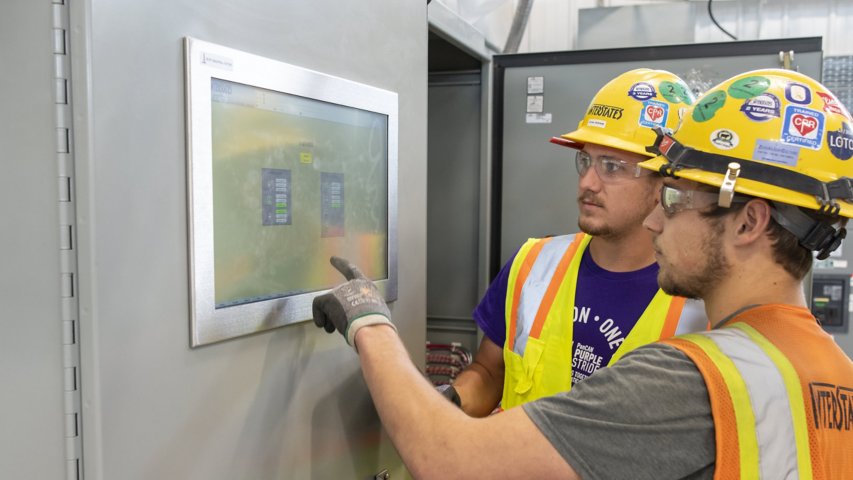Challenge
- Weekly software system crashes led to downtime and gaps of time without data collection
Solutions
Results
- New control and software system eliminated weekly downtime; ensured consistent access to data and reporting capabilities
- Access to untapped data helped company save $100,000 in waste water usage
Hatching a Food Giant
Tyson Foods has grown from a pioneer in meat production, to one of the largest producers of meat and poultry in the world.
Since its founding during the Great Depression raising baby chicks, selling animal feed and transporting chickens to market, the company has expanded to include major foods brands like Hillshire Farm, Ball Park and Jimmy Dean.
Beyond its foundations in meat processing, the company also owns other brands of tortilla chips, breadsticks, pizza crusts and more.
Prepared foods make up nearly 20 percent of Tyson’s annual sales.
The company manages all aspects of the production process for varieties of meatballs, sausages, bacon and meat products – from cutting and cooking to chilling and packaging.
Weekly System Crashes
Nearly 300 million pounds of classic favorites, such as hot dogs, deli meats and smoked sausages, are produced annually at the Tyson Foods plant in New London, Wisconsin, one of 38 prepared food facilities.
The operating system that supported the facility’s human machine interface (HMI) application was facing obsolescence.
The plant was relying on old PC hardware, which was, in turn, limiting which software system was used – some hardware was even running programs from the ‘90s.
The system was crashing weekly and often required two staffers – one from the operations side and one from IT – to stop what they were doing to get the system back up and running. All the while, production was still in progress.
While the system was down, operators lost visibility into production.
The facility also risked losing reporting data, which offered critical support for meeting U.S. Department of Agriculture (USDA) compliance parameters.
Once the system was back up and running, employees had to check production and utility systems, and reboot all applications. The entire process took several hours.
“The fact that the system was crashing every week was a sure sign that we needed to upgrade,” said Jonathan Riechert, senior engineer-innovation, Corporate Engineering Group, Tyson Foods.
“Beyond the USDA reporting issue, we knew that we couldn’t keep taking hours out of employees’ days to troubleshoot. A new operating system would be both a food safety and maintenance improvement.”
Operators understood they needed new hardware that could accommodate the software upgrade to give them reliable access to the data they required.
Accessing the Information
The New London facility started by replacing its aging production system with a new control and information system.
The new solution is based on the Rockwell Automation Integrated Architecture® system that incorporates both the Logix control platform and FactoryTalk® production management software.
The Logix platform offers scalable, plantwide control through tight integration between the software, controller and I/O modules.
The team developed the integrated control and information system based on successful solutions implemented at other Tyson facilities to provide the needed visibility and access to actionable data.
The information system incorporates both visualization and manufacturing intelligence operating on three virtualized servers to provide improved visibility to plant-floor data.
For the visualization system upgrade, Tyson Foods migrated 250 screens from FactoryTalk View32 software to a single FactoryTalk View Site Edition (SE) HMI application.
Engineering installed HMI tags with existing, predefined connections to the programmable logic controllers. This helped confirm tags are consistent with the old system and saved engineering time.
Operators now have real-time, comprehensive visibility into operations, such as tank levels and temperatures.
The new system includes alarms and events that enable operators to easily see and detect events throughout the facility.
The FactoryTalk View SE software integrates with WIN-911® to automatically trigger alarm notifications remotely via email.
The manufacturing intelligence solution builds on that plant-floor visibility by providing historical and trending information.
For this upgrade, operators migrated 1,000 historical tags from the past year over to the FactoryTalk Historian software, which now acts as the central repository for all production data from the control system.
This historical data, and the information retrieved through the facility’s real-time 960 data tags, are aggregated in FactoryTalk VantagePoint® enterprise manufacturing intelligence software.
The program correlates data and offers easy trending and reporting capabilities – a critical improvement for the New London plant.
From Insights to Action
The project was completed in just six months.
Since then, system crashes are no longer an issue. Operators no longer have to worry about losing access to USDA reporting data.
Reports are easily accessed and downloaded into Excel®. In addition to helping ease compliance, operators can now pull out specific information and create their own reports.
“Team members are empowered to create customized, robust reports. They can go into the application, drag and drop, and save whatever information they need. It’s so simple,” said Riechert.
In addition to helping ease compliance, these expanded reporting and trending capabilities have allowed the facility to save $100,000 in wastewater chemicals.
“The added visibility allowed us to see where inefficiencies were happening so we could adjust and refine our process,” said Riechert.
The alarm and events monitoring capability has helped the company cut maintenance-response time to help increase uptime.
The added insight can also be used to help improve worker safety.
For example, event notifications alert operators if employees are entering a certain work cell multiple times per day. Operators can then zero in on the cause, and identify a solution to keep the worker out of that area.
Because the system is relatively new, operators at the facility have yet to see yield improvements, though they expect any small increases in production to lead to an increase in profits.
“The FactoryTalk software suite has given us access to valuable information so we can really make use of it,” said Riechert.
“You can have all the data in the world, but the reporting and trending tools are what allow us to make it actionable.”
The results mentioned above are specific to Tyson Foods’ use of Rockwell Automation products and services in conjunction with other products. Specific results may vary for other customers.
Integrated Architecture, FactoryTalk and VantagePoint are trademarks of Rockwell Automation Inc.
WIN-911 is a trademark of WIN911 Software.
Excel is a trademark of Microsoft Corporation.
Published September 1, 2016




